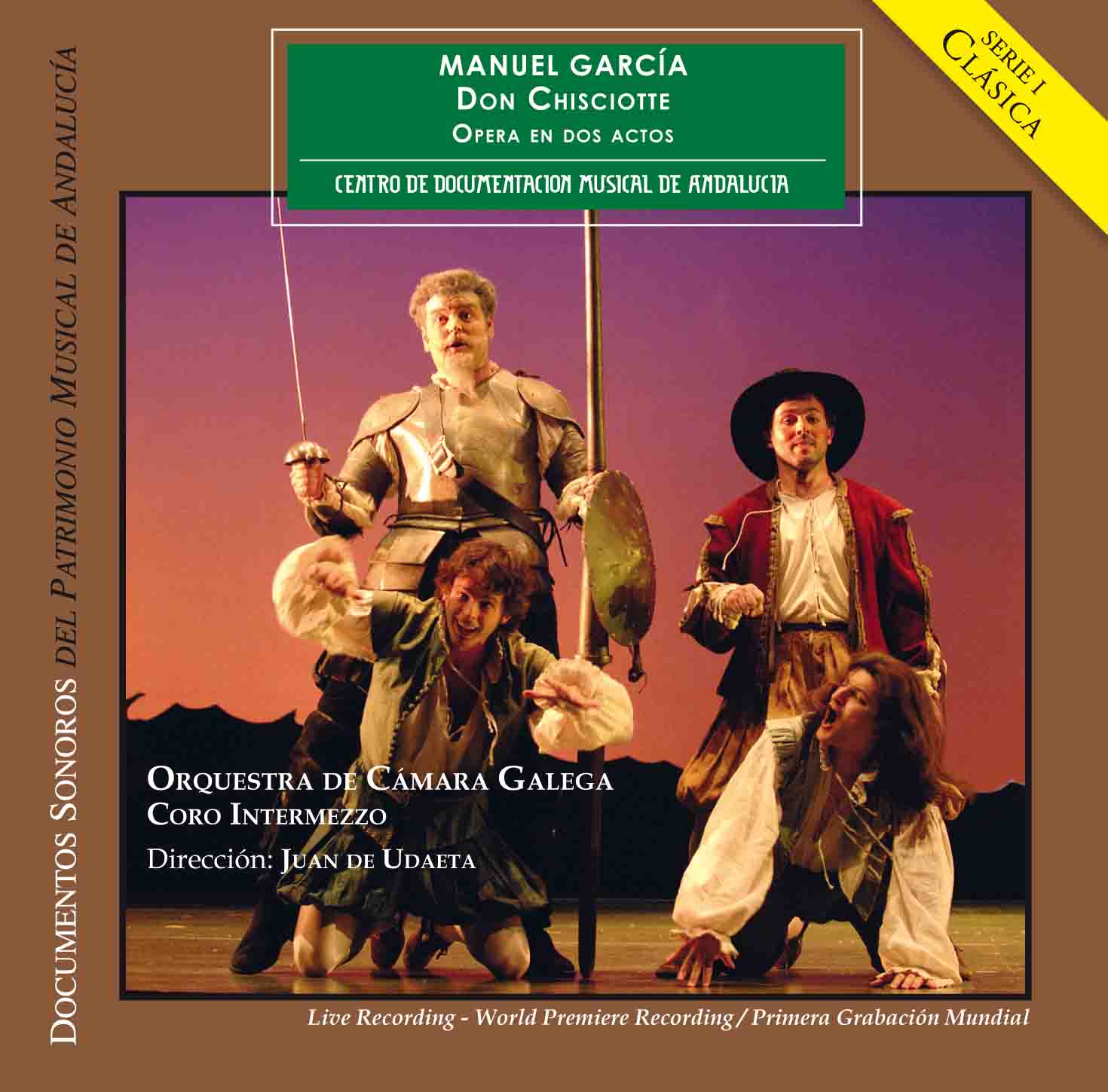Don Chisciotte. Ópera en Dos Actos
Detail DS-0149 You can buy this record here 17 € Don Chisciotte. Ópera en Dos Actos AGOTADO - SOLD OUT
AGOTADO - SOLD OUT
ATTO I 1- Obertura 2- Nº 1. Introduzione. Radipelo: Mio dilecto Ferulino... 3- Nº 2. Cavatina. Sancio Pancia: O stelle! O luna!... 4- Nº 3. Cavatina. Dorotea: Quanto mai lente per gl’infelici... 5- Nº 4. Duetto. Dorotea, Cardenio: Calmate l’affanno... 6- Nº 5. Scena ed Aria. Don Chisciotte: Benefico e vivace... 7- Nº 6. Duetto. Don Chisciotte, Sancio Pancia: Un gigante! Ah, dov’è? 8- Nº 7. Sexteto. Dorotea, Don Chisciotte, Cardenio, Sancio, Marcello, Radipelo: Generoso invitto eroe... 9- Nº 8. Scena ed Aria. Fernando: O ciel, invan io spero... 10- Nº 9. Finale primo. Sancio, Brunirosa, Marcello, Ferulino, Radipelo: Voi credete che gli eroi... ATTO II 11- Nº 2. Recitativo ed Aria. Sancio Pancia, Radipelo, Ferulino: Vittoria! Gran Vittoria... 12- Nº 3. Sexteto. Don Chisciotte, Lucinda, Dorotea, Cardenio, Fernando, Radipelo, Sancio Pancia: Qual ardire! Chi m’arresta!... 13- Nº 4. Recitativo e Duetto. Ferulino, Dorotea: Giorno fatal!... 14- Nº 5. Recitativo ed Aria. Cardenio: Fernando, Deh!... 15- Nº 6. Canone. Lucinda, Dorotea, Cardenio, Fernando: Dal fosco velo... 16- Nº 7. Scena ed Aria. Don Chisciotte, Sancio Pancia: Non mi chiudete... 17- Nº 8. Aria. Dorotea: Nato al mondo... 18- Nº 9. Finale. Coro: Non si vede in questo giorno... |
About AGOTADO - SOLD OUT
Manuel García
The tenor, composer, impresario and singing teacher Manuel del Pópulo Vicente García (Seville, 21-I-1775; Paris, 10-VI-1832), was one of the most important figures in nineteenth-century Spanish music. The father of Pauline Viardot-García, María Felicia, the legendary Malibrán, and of Manuel Patricio García, and the inventor of the laryngoscope, he was one of the great personalities in European operatic life of the nineteenth century. Both Rossini’s and Mozart’s favourite performer, he was one of the father of the bel canto school. But he was also a magnificent composer, a facet of his life that has been completely forgotten. From his early years of music training and his first performances in his native Andalusia, until his death in Paris in 1832, Manuel García led a multi-faceted life. Only such extraordinary talent and personality can explain his legendary reputation as a singer, his mythical performances reaching all of the great European lyric centres. To a large extent, this could explain why other facets of his talent, such as his work as a composer, are lesser known today. His musical career commenced in Seville and Cádiz, where apart from beginning to learn music, he was first noticed for his talent as a choirboy. His performances of lyric music would soon shape his musical personality, as well as his exceptional acting talent. His Andalusian years and the circumstances of his marriage to Manuela Morales would combine to form a unique character and personality, which would cause him none-too-few difficulties in the future, due to his nature and temperament. The works El majo y la maja, La declaración, El seductor arrepentido, El reloj de madera and Quien porfía mucho alcanza date from his early period in Madrid. In 1804 he premiered his opera in prose in one act El criado fingido, containing the very well known polo Cuerpo bueno, alma divina. One of his most important works from this period, and which would subsequently pave the way for his entry into Parisian musical circles dates from 1805: El poeta calculista, the opera-monologue featuring the famous polo Yo que soy contrabandista. García quickly outgrew the Spanish musical circles, leaving for Paris in 1807, where he combined performing as a singer with the composition of his first works, “tonadillas” and “operettas”, which he himself premiered, together with his second wife Briones. From this point onwards, García appeared in the most important European lyric centres as both “primo tenore” and composer. The period he spent in Italy (1811-1816) not only marked the beginning of his singing career –there he met the young Rossini, for whom he premiered Elisabetta, regina d’Inghilterra and Il barbieri di Siviglia–, but as the successful composer of Il califfo di Bagdad (1813). During this period he also concentrated on learning and dominating vocal technique with the legendary Giovanni Anzani –who, in turn, inherited Porpora’s Italian vocal tradition.
|


 After subsequently appearing in Paris and London as a singer, García the composer simultaneously continued his opera output with its international style and projection, following the two most fashionable styles of the time: the Italian and the French, although without forgetting the influence of Spanish music. 19 operas in Italian and eight operas in French have survived from this period, as well as a large number of operas in Spanish, some of the most famous including Il califfo di Bagdad and La mort du Tasse. In 1825 García and his family embarked on a trip to America, taking in New York and Mexico. Mozart’s and Rossini’s music reached the New World for the first time. The subject of the present edition, Don Chisciotte, is another opera possibly dating from this last period.
After subsequently appearing in Paris and London as a singer, García the composer simultaneously continued his opera output with its international style and projection, following the two most fashionable styles of the time: the Italian and the French, although without forgetting the influence of Spanish music. 19 operas in Italian and eight operas in French have survived from this period, as well as a large number of operas in Spanish, some of the most famous including Il califfo di Bagdad and La mort du Tasse. In 1825 García and his family embarked on a trip to America, taking in New York and Mexico. Mozart’s and Rossini’s music reached the New World for the first time. The subject of the present edition, Don Chisciotte, is another opera possibly dating from this last period.